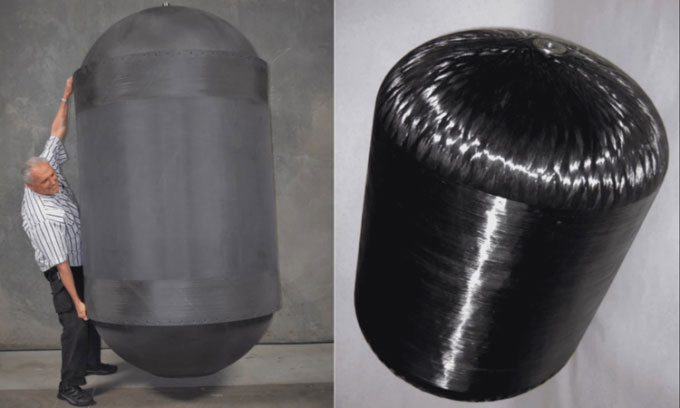Ultra-light fuel tank holds more than 150kg of hydrogen
The new fuel tank can help hydrogen aircraft fly four times farther than today's traditional fueled planes, and at the same time emit no carbon.
HyPoint has partnered with Gloyer-Taylor Laboratories (GTL) to develop an ultralight cold fuel tank with the potential to significantly increase the range of hydrogen-powered aircraft, New Atlas reported on April 22. Ultralight tank made of graphite fiber composites and other materials.

The fuel tank is 2.4 m long, 1.2 m in diameter and weighs only 12 kg.
GTL says it has built and tested several cryogenic tanks, determining them to be up to 75% less massive than current aerospace cryogenic tanks made of metals or composites.
The reduction in mass makes a huge difference when using a very light fuel like liquid hydrogen. According to Val Miftakhov, founder of ZeroAvia, with a typical compressed air hydrogen tank, the typical mass ratio (how much fuel contributes to the weight of a full tank) is only 10-11%. In other words, each kilogram of hydrogen requires tanks weighing up to 9 kilograms to transport it.
Liquid hydrogen could allow hydrogen aircraft to beat conventional kerosene-powered aircraft in terms of range, Miftakhov told New Atlas 2020. "Even with a 30% mass ratio, that's achievable. with a liquid hydrogen tank, the benefit of the resulting hydrogen system will be higher than that of the jet fuel system per kilogram," he said.
The new cold tank is 2.4 meters long, 1.2 meters in diameter and weighs only 12 kilograms, GTL said. After adding the necessary equipment, the total weight of the tank is 67 kg and is capable of holding more than 150 kg of hydrogen. As such, the mass ratio is up to nearly 70%, resulting in significant volume savings. When adding coolers, pumps and other things, the mass ratio of the whole system is still more than 50%.
With a mass ratio of more than 50%, clean fuel aircraft can fly up to 4 times farther than equivalent jet fueled aircraft, reducing operating costs by 50% (calculated on a per-passenger cost basis). per kilometer), while completely eliminating carbon emissions, according to HyPoint.
For example, a De Havilland Canada Dash-8 Q300 aircraft with 50-56 passengers can fly about 1,558 km on jet fuel. When equipped with fuel cell powertrain and GTL tank, it can fly up to 4,488km. "That's the difference when this plane is traveling from New York to Chicago with a high carbon footprint, and when it is traveling from New York to San Francisco with zero carbon emissions," said Sergei Shubenkov, co-founder. HyPoint, said.
From electric vertical take-offs to large intercontinental aircraft, most operators want to increase range, reduce costs, eliminate carbon emissions or simply reduce weight to increase the carrying capacity of goods or passengers. Therefore, the new ultra-light fuel tank promises to bring many changes to the aviation industry.
- Find out the location of the car fuel tank cap
- There is going to be a clean fuel made from light and fat
- Cause and how to handle when water in the car fuel tank
- Why can a 50-liter petrol tank flow to 56 liters?
- Material promises to make the tank super light
- What does the fuel tank of a blown rocket look like?
- Find an extremely effective, surprisingly cheap hydrogen extraction method
- Road-driven cars: the world's most efficient method of hydrogen production
- The fuel tank of Discovery ship appeared 2 cracks
- Germany is keen on using hydrogen fuel trains next year
- Breakthrough in cheap hydrogen fuel production
- Planting nano trees, harvesting hydrogen fuel
 'Fine laughs' - Scary and painful torture in ancient times
'Fine laughs' - Scary and painful torture in ancient times The sequence of numbers 142857 of the Egyptian pyramids is known as the strangest number in the world - Why?
The sequence of numbers 142857 of the Egyptian pyramids is known as the strangest number in the world - Why? History of the iron
History of the iron What is alum?
What is alum?